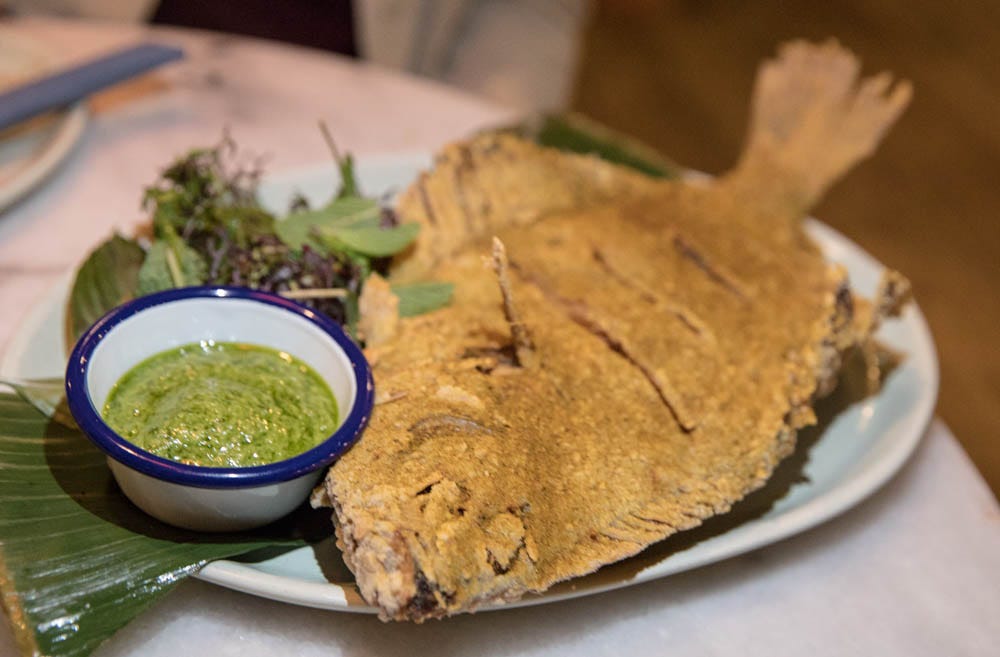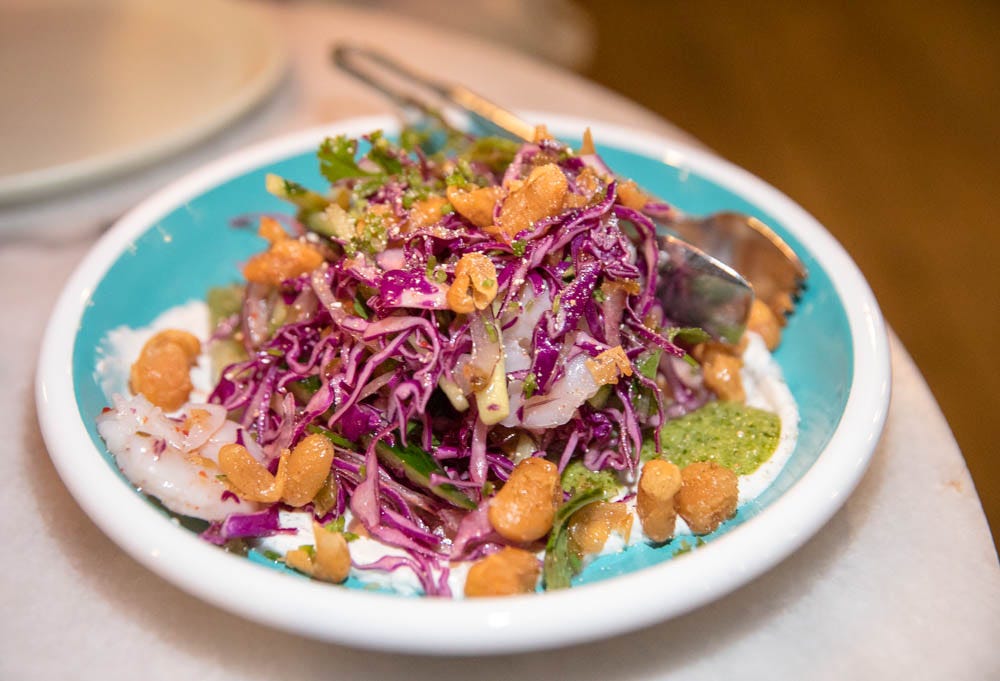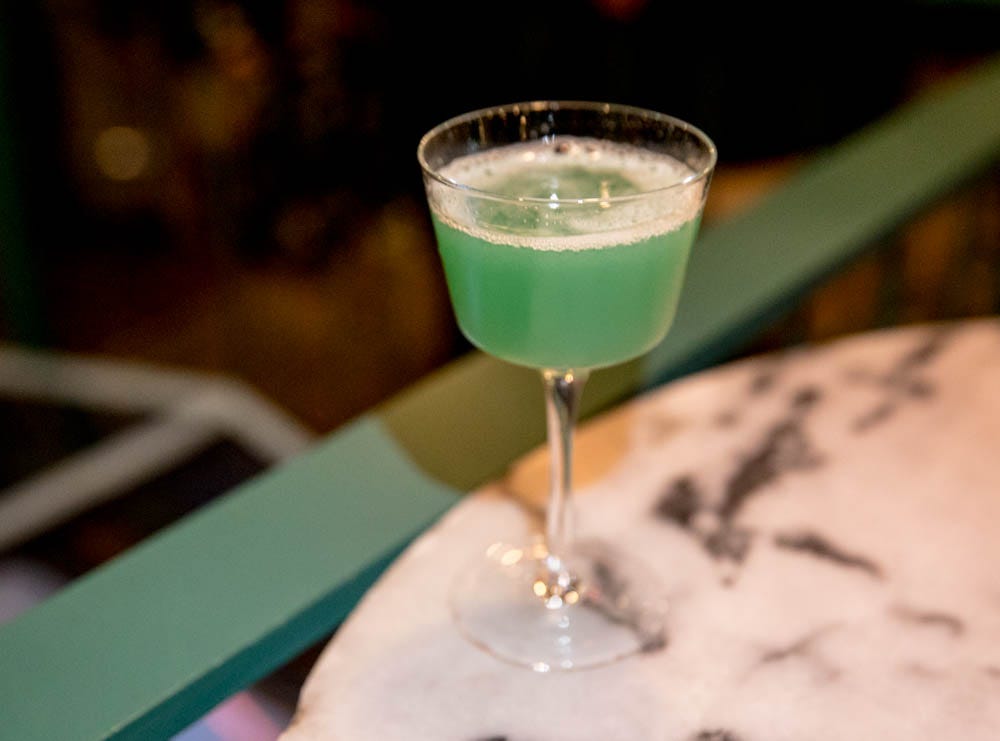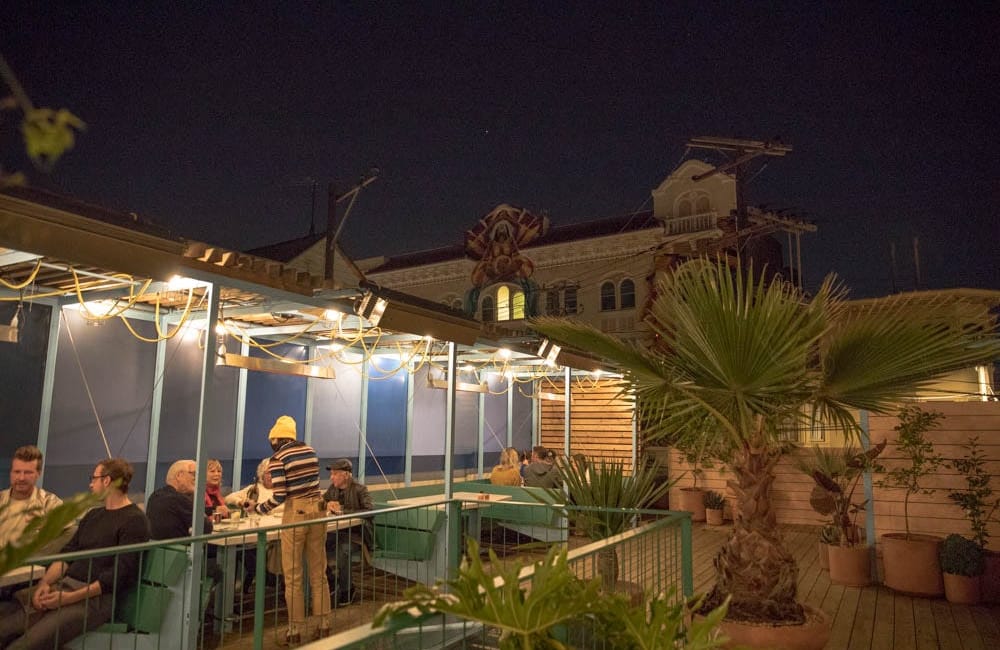Visions of rooftop Hong Kong spots are sparked, marked by graffiti art, plants, and a nighttime glow. I also recall Bangkok bars, like the vibrant outdoor space and wall art of Tropic City, a rum/mezcal/pisco bar. But we’re not in Asia. We’re in San Francisco at Good Good Culture Club (GGCC)—which opened January 14, 2022—from chef Ravi Kapur of beloved Liholiho Yacht Club, and partner Jeff Hanak. The rooftop holds all those elements, feeling worlds away, and on these balmy, warm nights as I write, Asia feels like an easy transport.
The 18th Street space formerly housed Dear Inga from Kapur and the team. I wish its modern Eastern European food had a chance to take flight if the pandemic hadn’t interfered. Dear Inga assuaged a void still deeply felt by me ever since Bar Tartine closed — nowhere have I tasted the kind of modern Hungarian-meets-Japan food chef Nick Balla created from his background. While I hope others consider this much-needed void (better yet, Balla returns with a new restaurant), it’s clear Good Good Culture Club (GGCC from here on out) is already hit and what the space needed. It’s packed every night, really tough snagging a reservation and crowds line the sidewalk to get in.
That’s a downside, indeed, but after a couple visits (trying a good ⅔ of the menu and all but one of the cocktails), it already feels like an SF staple — and the team’s core values (including equitable pay, overall well-being, inclusivity, etc.) permeate through a team that seems committed and happy to be there. They even go about selecting spirits and wines from companies that are inclusive, offer fair pay and/or elevate women in leadership. You can almost feel the intentionality in the colorful, sunny vibrancy of the space.
Kapur is the first to say GGCC is not “modern Asian” food, just as he has said Liholiho is not modern Hawaiian. Of course, for the average diner, a rootless, vague description without a sense of cuisine focus isn’t helpful when deciding where to dine from among literally hundreds upon hundreds of superb restaurants in SF alone, much less the Bay Area. Some defining core is necessary for a start. The bigger issue, after all, is not in dubbing something “modern Asian or Hawaiian,” but that the average person doesn’t understand what those cuisines and histories entail to begin with.

The flavors at GGCC are decidedly and predominantly Asian, although the vastness of that continent’s incredibly varying cuisines is already a very loose boundary. Certainly you could call it “New American,” but that term means little except “fusion” since the U.S. is the ultimate “melting pot.” The part that is actually boundary-less is Kapur’s unique style expressed on a plate. There are hundreds I would count as superlative among the 12,000+ restaurants I’ve been to around the world. But there is a much shorter list of chefs whose voice I would say I can taste on the plate. These chefs are so singular, the way it all comes together could only be expressed by them, not unlike a musician who is less an imitator and more a melange of the many different sounds that have influenced them.
Kapur is one such chef. Not unlike Stuart Brioza at State Bird Provisions/The Progress/The Anchovy Bar, or Dominique Crenn of Atelier Crenn, as a couple local examples, when you taste one of their plates, you know it’s theirs. Of the numerous times I dined at Liholiho since it opened — deeming it one of the best new openings 2015 when I was editor at Zagat — I celebrated the way it took Hawaiian cuisine to the next level. As someone who deeply loves, has traveled around and studied the cuisine and history of Hawaii, it’s a unique cuisine, born from a mashup of the islands’ roots and many Asian countries with a touch of Portugal, just as Cajun and Creole cuisines are the collision of foods from countries around the world, resulting in their own gloriously unparalleled cuisines.
This understanding of Hawaiian cuisine is already a broad enough definition. As an Oahu native, at Liholiho (set to reopen this Spring), Kapur played with Hawaiian dishes, ingredients and their Asian roots in brilliant dishes like housemade spam or his mother’s butter mochi recipe (that dessert an evolution with Japanese roots but distinctly Hawaiian take). The result was a spotlight on the possibility of Hawaiian cuisine, a broader vision I longed to see in the islands of Hawaii (though a completely different style, chef Chris Kajoika is historically one I’ve seen play with the edges of Hawaiian cuisine in Hawaii — he also has deep ties cooking at SF restaurants).

So when you approach the menu at GGCC, your expectations will be surpassed and boundaries expanded, to be sure. But you’ll recognize flavors of Asia, from the Philippines to Thailand, in a form you haven’t yet seen. This menu is as dynamic as Liholiho’s over the years, and GGCC’s space rises to meet that exuberance.
From the neon sign querying (like my Sicilian great aunties), “Did you eat yet?”, to hits of neon pink, turquoise, and green, to a mural from local Kalani Ware, the bustling downstairs dining room and bar feels like a laid back party. Heading upstairs to the open-air rooftop, the same color scheme and an array of plants gaze across the block to the Mission’s iconic Women’s Building Maestrapeace mural, evoking somewhere between Mexico and Southeast Asia. Nicely spaced-out tables are ideal for groups, keeping it festive, though it’s blessedly less noisy than downstairs.
Working with co-chefs Kevin Keovanpheng and Brett Shaw “celebrating heritage through food,” per their Insta, Kapur and team’s menu runs heavy on generously shared plates. The signature Good Good chicken wing is juicy with properly crispy skin in an adobo glaze, stuffed with garlic rice, but it’s the poppyseed steam bun packed with smoked oyster sauce-rubbed beef belly in curry aioli that converts me among those large “bites.” The burnt ends-esque crust on the tender beef recalls Texas brisket, the bun soft and airy around it.
A whole fried petrale sole brined in turmeric coconut milk — accompanied by a palapa herb salad — was irresistibly crunchy yet moist and flaky inside, transporting me back to my month in Vietnam just over 20 years ago where I frequently ate fried whole fish with herbs making an elevating partner.

For me, the dishes that most exemplify Kapur’s (and the chef team’s) unique perspective all line the first section of the menu with light, airy salad vibes but meaty, fascinating contrasts. Crying tiger shrimp are cool and plump, benefitting from a contrast of cucumber, lightly fried butter beans, mint, red onion on a bed of coconut-makrut lime cream.
Ubiquitous brussels sprouts when shaved make an ideal salad, while Monterey squid is among the best in the world, fresh for us lucky neighbors of Monterey. Together, it’s one exciting salad dotted with pomello and fried bits of tripe (if you fear tripe, you won’t even know what hit you as you down that crispy goodness) in hot mustard dressing. Paper-thin beef carpaccio lays under a bed of frilly red mustard leaves, strips of shinko pear in housemade mae ploy chili sauce with crispy pig ears adding crunch. All three are vivid, surprising, each an explosion of flavor and opposites. They’re blessedly light yet not lacking in punch. Signature Kapur.
Bar director Janice Bailon (who bartended for years at the likes of Bourbon & Branch and The Perennial) goes playful and colorful. While tropical vibes imbue drinks like vodka-based, coconut milk-clarified Pink Flamingos (with pomegranate, hibiscus, lychee, kumquat, lime), the drink is a bit subtle with some dishes. I prefer the also pink Vacation Away (blanco tequila, rosé vermouth, guava, lime, bubbles) balanced with a touch of guava, cooling a number of dishes as it holds its own. The Poolboy, given its soothing blue-green hue from blue spirulina, pairs beautifully with its base of Animas Mezcal, bitter and herbaceous whispers of Aveze Gentian and Yellow Chartreuse, and tropical perk from Giffard passionfruit and lemon.
The cocktail standout was unexpectedly Home by the Sea, essentially the profile of a gin and tonic but more complex and buoyant, inspired by Bailon’s time at The Perennial focused on environmental sustainability in food and drink. Japanese Roku Gin, Sidetrack Shiso liqueur, and plum sake already makes an herbal, earthy, aromatic base with tonic. Bailon adds li hing mui preserved lemons and it’s a total win: salty, sour, lively in all the right ways.

Her savvy spirits’ list scores with a curated selection from ethical producers, slightly leaning towards rum and agave, the most notable surprise being the brandy section (a Dear Inga remnant). I found longtime loves of mine like Reisetbauer, an Austrian schnaps (dry, clear fruit brandies) distillery, including their fabulous carrot, ginger, cherry, pear, and plum schnapps, which pair quite nicely with the food.
Liholiho wine director/dining room manager Aimee Arcilla (who came from the likes of Californios) offers a judicious list of wines like 2020 Koehnen Sauvignon Blanc skin contact wine, biodynamic with a subtle, elegant funk. While all wines can be thankfully be ordered by the glass (you have to ask them to add it to your tab), they’re listed as 9 oz. carafes, making pricing more reasonable for two glasses. Expect balanced natural wines like zippy Durante Le Spinee Bianco Frizzante Pet Nat or chilled red 2020 Stoumen Post Flirtation, a blend of Carignan and Zinfandel.
A $60 per person Ohana Menu is just for groups of 8–16, but an affordable way to try a cross-section. With 20% service charge automatically added to each bill to equitably support all staff, requesting dishes or drinks via ToastTab on your phone when ready for each item (they come out in a timely manner), helps you pace your own meal, though it all adds up swiftly. It’s easy to spend $200 for two with a few plates and drinks. But this is reflective of the steep inflation of goods in pandemic — and the important cost of equity in an industry long without it.
GGCC’s team was tight, friendly, and consummate two weeks in — and was the same when I returned a couple weeks later. Energy is high from diner and staff alike, the space transporting as the food and overall experience. I can’t help but immediately feel similar feels as I did when Liholiho opened. There is no other place or menu quite like this in the nation. The bad news is, this means it will likely be packed nightly for the foreseeable future. The good news is that should (hopefully) mean it will be around for a long time to come, settling in as another “only in San Francisco” kind of dining experience, one that nurtures the heart as it does the belly and palate from a team united around core values we long to see more of in the world.
// 3560 18th Street, https://goodgoodcultureclub.com







